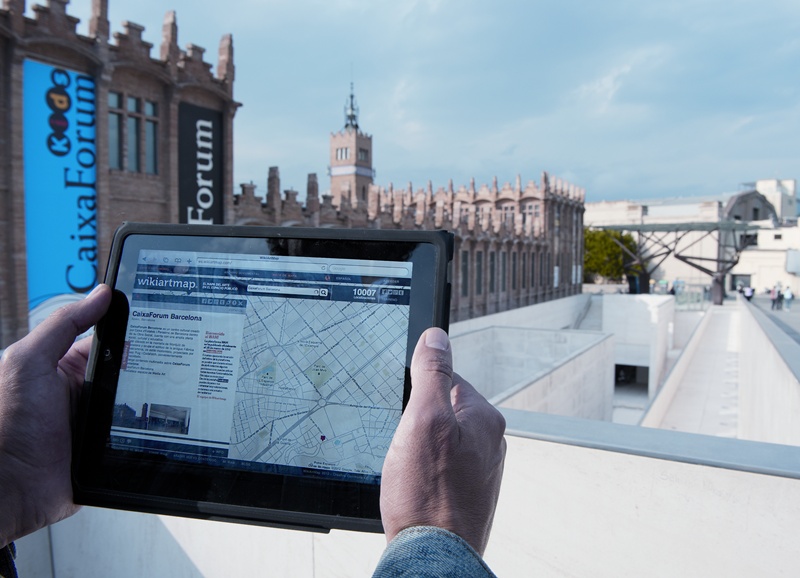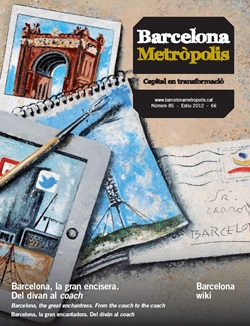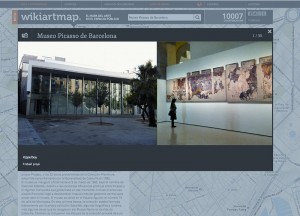
© Albert Armengol
A Wikiartmap user consults the service on his digital tablet in the area near CaixaForum.
Maite Oliva, the driving force behind Wikiartmap, tells us that it all began three years ago when she was curating a series of open-air photography exhibitions and realised that there was no tool for disseminating the creative work that is shown in public spaces. That tool is now the newly-launched Wikiartmap. But it is more than that. “It’s a global platform where people can advise and enter content to put on the map any information relating to art, creativity and historic and cultural heritage that is accessible and outdoors,” explains Oliva.
This young lady from Figueres has taken Wikipedia and Google as her reference points “because of their vision when creating new tools that other people can then use to develop other applications”. That is precisely what she has done, using Google maps and texts from the free online encyclopaedia.
Her project was always intended to be global. “If the tools allow it, why limit it? There were already maps for specific organisations, but this project wants to go much further, with an international reach and dynamic content.” The platform will soon be accessible in six languages: Catalan, Spanish, French, English, Italian and Portuguese.
Oliva is well aware that this is a collective effort and she emphasises that she and her team have only laid the first stone of a project that will grow through everyone’s contributions. “I think it will be useful for helping artists to spread their work. We also provide statistics that can be useful to various organisations and players on the arts scene. It will also help to spread heritage. All the tools can be freely used by any user.”
Wikiartmap is on social networks such as Facebook, Twitter and Google+, and it will also work on its own social network to allow users to share and follow content or to illustrate their own blogs with maps. Everyone is invited to take part in constructing this art dictionary: the developers point out that “it doesn’t have to be perfect; it’s about wanting to describe our cultural heritage that is there for everyone”. However, neutrality is advised, although we all know that in this domain “what is crucial for some is questionable for others”.
Oliva was always very clear about this aspect of free use of her project and she insists that “the authorities must support open content”. Wikiartmap is a tool that is operated under a Creative Commons licence and incorporates and restructures existing content from Wikipedia and its Catalan language version, Viquipèdia. It also allows users to add new content, referencing them on the map and cross-referencing them. To make the tool a really good source of information, a mechanism has been created to review the content suggested by users.
Various categories have been created to help navigate all this information, and they give an idea of the project’s scale: architecture, sculpture, wallcovering, sketch, sound creation, festivals, urban exhibitions, etc. The contents are located on the map and the user can search by place, genre or keyword. The map always displays 100 entries ordered by popularity, never by any quality criteria. The information files open up on the map itself so that the user never loses the location.
To give an example: if you want to know where all of Gaudí’s works in Barcelona and its surrounding areas are, you can either click on the map, enter the architect’s surname or type in modernisme. The information that comes up will be pictures and texts that already exist online, but you will have come to it via a different route. In other words, this is not an encyclopaedia compiled for specialists; its basic purpose is to disseminate and provide access to these contents. Its dynamic structure also makes it a useful tool for finding out about the latest artistic events, even if they are ephemeral, like exhibitions or happenings.
The initiative was publicised this spring at the Santa Mònica Arts Centre in Barcelona and is supported by the Spanish Ministry of Culture, Girona Provincial Government, the Girona Costa Brava Tourist Board, Figueres Town Council and the Pyrenees-Mediterranean Euroregion. In order to continue to move forward it is working to secure the support of private partners who see opportunities in the tourism and arts industry.




